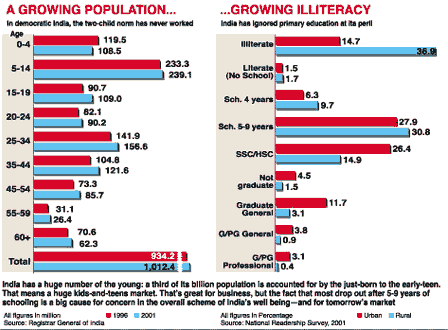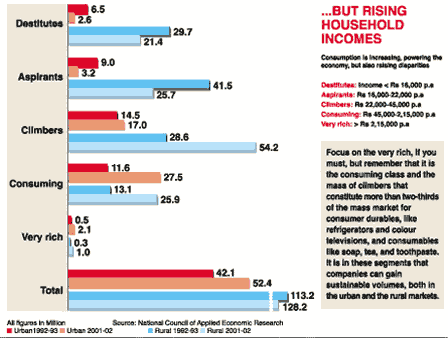|
 The
socialist code of restraint dictated much of independent India's
consumer psyche until the late seventies and early eighties. It
was a time when per capita income grew by an imperceptible one per
cent per annum. A whole generation was raised on a diet of austerity,
where thrift was a great virtue, and where anything except basic
consumption was frowned upon. The
socialist code of restraint dictated much of independent India's
consumer psyche until the late seventies and early eighties. It
was a time when per capita income grew by an imperceptible one per
cent per annum. A whole generation was raised on a diet of austerity,
where thrift was a great virtue, and where anything except basic
consumption was frowned upon.
Much of this stemmed from the licence raj,
where consumption was literally rationed. Many of us may not remember
that the Bajaj Chetak scooter was once an object of desire: you
could buy it either through foreign currency off-the-shelf or wait
a couple of years! We do, of course, recall the waiting period to
get tinpots like the Hindustan Motors' Ambassador or Premier Automobile's
Premier Padmini. Right until 1980-81 the per capita income was just
under Rs 2,000 (at 1998-99 prices), even while the household saving
rate was a high 18-20 per cent. Not surprisingly, it was an era
of value for money.
The real impetus for consumption began well
before liberalisation with V.P. Singh's 1985 budget that brought
down the peak income tax rate from 97 per cent to 50 per cent. Suddenly
the people's car, Maruti 800, became affordable, as per capita income
grew three-fold to reach more than Rs 6,000 by 1990-91. From that
point on, we discarded the legacy of penny-pinching. The consumer
was young, professionally-educated, and motivated. Jobs were increasing
and thousands turned their thoughts to entrepreneurism.
The world also flooded into our homes in 1991
through cable and satellite television. Newer and better goods abounded:
toiletries & cosmetics, durables, electronics, food and beverage,
two-wheelers, and cars-a smorgasbord of choice was evolving. The
availability of credit made it possible to consume now and pay later,
even as consumers reached out for more lucrative, high-yielding
investment means to sustain their lifestyle. That, of course, sometimes
impaired rationality and led us into scams of all nature: stocks,
plantations, non-banking financial companies, to name a few.
Even as consumption grew, its nature remained
uniquely Indian. The family remained central to the whole process
of consumption, even giving it legitimacy. The Indian consumer may
have left mindless thrift behind her, but she will still bargain
for basement prices. And as bright new things like mobile phones,
automated banking, ready-to-eat food, and the internet enter our
lives, the cultural idiom remains paramount in consumption.
The supremacy of the Indian idiom has forced
global marketers to cater to our way of life. And so we have Domino's
selling Hot Sams (the humble samosa, baked, not fried, stuffed with
Chettinad chicken or paneer), McDonald's inventing the Maharaja
Mac, and along the way banning two vital ingredients: beef and pork.
Those that could not adapt to the Indian way, like Kentucky Fried
Chicken, stumbled towards losses-and near oblivion.
Marketing: What Works In
India
 |
| Quality and globalisation is fine, but what's
the discount? |
Marketers have
discovered, sometimes at their own peril, that frugality is an eternal,
omnipresent virtue in India. It holds true no matter what, where
or to whom you're selling. McDonalds in India needs the Rs 7 ice-cream
cone as a beacon to get the consumer in. And marketers across product
categories in soaps, detergents, tea, coffee, even carbonated soft-drinks
swear by small pack sizes. Gillette sells its top-notch Sensor Excel
shaving blade in a single-pack only in India. Brands are welcome,
but the Indian consumer won't pay a premium just for the intangible.
Indians won't throw away anything, so enter
Akai and its legendary exchange-led bonanza for colour TVs. And
virtually the entire consumer-durable industry, from washing machines,
refrigerators, music systems, two-wheelers, even trucks (yes, trucks!)
latched on to the exchange bandwagon. And if you want the consumer
to change her consumption behaviour, you need to be patient, and
use dollops of staying power, much like Kelloggs did. For, the Indian
consumer will never, but never, change in a hurry, proof of which
is the graveyard of marketers who thought otherwise: instant-dosas,
cut-and-dried vegetables, vaccumisers, the list can go on.
Humour, in advertising, is welcome as long
as it knows its limitations, for the Indian consumer doesn't allow
its heroes and holy cows to be lampooned, much like the controversial
Pepsi ad on its arch-rival Coke's endorser, Hrithik Roshan. Cricket
cuts across age, sex, geographic barriers, and is used as a potent
tool for advertising just about everything. Rebellion of any kind
is out, even though individualism is in, but remember that for any
high-value purchase-a colour TV, refrigerator, car, even holidays-the
target consumer is the entire urban Indian family, not an individual.
-Shailesh Dobhal
The
Two Faces Of Indian Consumerism
 |
| URBAN: A world of hype, hypermarkets,
and satellite television |
A good monsoon
cheers not just the humble, often illiterate, farmer in the ubiquitous
Indian village, but the powers that be in government and corporate
India. For a mere one percent increase in India's rural income translates
to a whopping Rs 10,000 crore of buying power. Nearly half of India's
buying potential resides in its villages, as is clear from the sales
figures of India's biggest consumer marketer. Nearly half of Hindustan
Lever Limited's Rs 10,948-crore sales come from rural India.
And even though they may appear, on the surface,
as different as chalk and cheese, the Indian urban and rural consumer
differ largely only in their price-sensitiveness, which in turn
reflects the age-old urban-rural income disparity.
 |
| RURAL: The reign of the travelling salesman
and the painted wall |
For HLL sells the same shampoo brands in rural
areas, but in low-priced satchets. For others like Videocon (colour
televisons) and Hero Honda (motorcycles), the rural differentiation
and therefore focus is price. For nearly a third of all stock (till
2001) of premium luxury goods like colour televisions, two-wheelers,
refrigerators, and washing machines was accounted for by rural India.
Why, nearly two-thirds of all middle-income households in the country
(with annual income between Rs 30,001 to Rs 1,25,000) are in rural
India.
Where rural and urban consumers really differ
is largely in their reach for marketers, both in terms of physical
distribution and reach through various media. And it is here, while
adopting operational plans, for urban and rural consumers that India
seems to be torn right across this urban-rural divide. So even while
urban India is toying with international retail models in hypermarkets,
discount stores, speciality retailing and the like, tapping the
two-lakh odd rural haats (periodic fairs) remains a priority for
marketers across product genres. And while cable and satellite television
assures a marketer nearly half of all urban audiences, it reaches
not even a tenth in rural India. This is a land where wall paintings
and terrestrial television (read Doordarshan), still reign.
-Shailesh Dobhal
THE INDIAN CONSUMER: WHAT
A LONG, STRANGE TRIP IT'S BEEN |
 |

|

